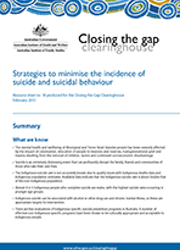Summary
This resource sheet provides a review of policies and programs that aim to prevent suicide and suicidal
behaviour. Suicidal behaviour refers to actions that can result in death, such as taking an overdose or deliberately
crashing a car. The scope of this resource sheet does not include self-injury that is part of the cultural grieving
process (‘sorry business’).
While it is known that high levels of mental health and wellbeing decrease the risk of suicide (Zubrick et al. 2005),
programs to promote mental health and wellbeing are also not considered in this resource sheet, as they are
the subject of a separate resource sheet Strategies and practices for promoting the social and emotional wellbeing
of Aboriginal and Torres Strait Islander people (CtG 2013). Effective mental health promotion programs include
cultural healing programs, culturally appropriate mental health services and the Indigenous Hip Hop program.
Also important are Indigenous adaptations of effective mainstream programs such as the Resourceful Adolescent
Program, MindMatters (a mental health promotion program for secondary schools) and the Triple P-Positive
Parenting Program.
Suicide is strongly associated with the use of alcohol and other drugs (Hanssens 2008; Hunter et al. 1999; OSCWA
2008). Strategies to reduce alcohol and other drug-related harm are also not included as they are the subject of a
separate resource sheet Reducing alcohol and other drug related harm (Gray & Wilkes 2010).
This resource sheet considers suicide prevention policies and programs that have been implemented in both
remote and non-remote parts of Australia and internationally. It assesses their strengths and limitations and their
actual, or likely, effectiveness in relation to Indigenous Australians.
Summary
- What we know
- What we don’t know
Introduction
Background
Suicide prevention policies
Cultural continuity and youth suicide
Effective suicide prevention programs
Effective non-Indigenous-specific suicide prevention programs
Conclusion
Appendix A
Appendix B: Some characteristics of Indigenous suicide in Australia
End matter: Acknowledgments; Abbreviations; Terminology; Funding; Suggested citation; Copyright



